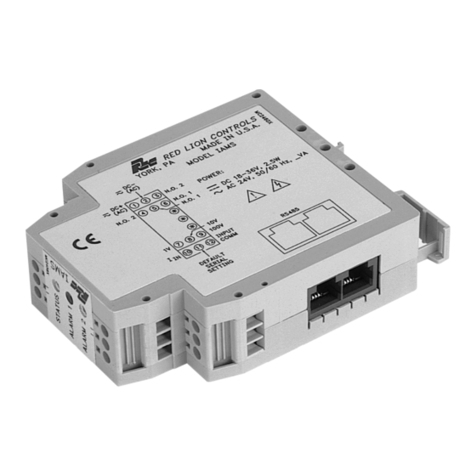2 3
SYMBOL IDENTIFICATION
Triangle with an exclamation mark: Warning / demand.
Potentially lethal situations.
The CE mark proves the compliance of the devices with
the essential requirements of the directives.
The double insulation symbol shows that the devices
are protected by double or reinforced insulation.
SAFETY INSTRUCTIONS
DEFINITIONS:
Hazardous voltages have been defined as the ranges: 75 to 1500 Volt DC, and
50 to 1000 Volt AC.
Technicians are qualified persons educated or trained to mount, operate, and
also troubleshoot technically correct and in accordance with safety regulations.
Operators, being familiar with the contents of this manual, adjust and operate
the knobs or potentiometers during normal operation.
RECEIPT AND UNPACKING:
Unpack the device without damaging it and make sure that the manual always
follows the device and is always available. The packing should always follow
the device until this has been permanently mounted.
Check at the receipt of the device whether the type corresponds to the one
ordered.
ENVIRONMENT:
Avoid direct sunlight, dust, high temperatures, mechanical vibrations and shock,
as well as rain and heavy moisture. If necessary, heating in excess of the stated
limits for ambient temperatures should be avoided by way of ventilation.
All devices fall under Installation Category II, Pollution Degree 1, and Insulation
Class II.
MOUNTING:
Only technicians who are familiar with the technical terms, warnings, and instruc-
tions in the manual and who are able to follow these should connect the devices.
Should there be any doubt as to the correct handling of the devices, please
contact your local distributor or, alternatively, Red Lion Controls Worldwide
Headquarters, 20 Willow Springs Circle, York, PA 17406 USA, Phone: +1 (717)
767-6511, Fax: +1 (717) 764-0839
32
WARNING!
The IAMS devices are designed for connection to hazardous
electric voltages.
Ignoring this warning can result in severe personal injury or
mechanical damage.
To avoid the risk of electric shock and fire, the safety instruc-
tions of this manual must be observed and the guidelines
followed. The specifications must not be exceeded, and the
devices must only be applied as described in the following.
Prior to the commissioning of the devices, this manual must be
examined carefully.
Only qualified personnel (technicians) should install these
devices. If the equipment is used in a manner not specified by
the manufacturer, the protection provided by the equipment
may be impaired.
WARNING
To keep the safety distances, the relay contacts on the devices
must not be connected to both hazardous and non-hazardous
voltages at the same time.
The IAMS devices must be mounted on a DIN rail according to
DIN 46277.
WARNING!
Until the devices are fixed, do not connect hazardous voltages
to the devices.
The following operations should only be carried out on discon-
nected devices and under ESD safe conditions:
General mounting, connection and disconnection of wires.
Troubleshooting the devices.
Repair of the devices and replacement of circuit breakers
must be done by Red Lion Controls only.
HAZARD-
OUS
VOLTAGE
INSTAL-
LATION
GENERAL
WARNING
Do not open the front plate of the devices as this will cause
damage to the connector for the display / programming module
PGMMOD00. The devices contain no DIP-switches or jumpers.




























